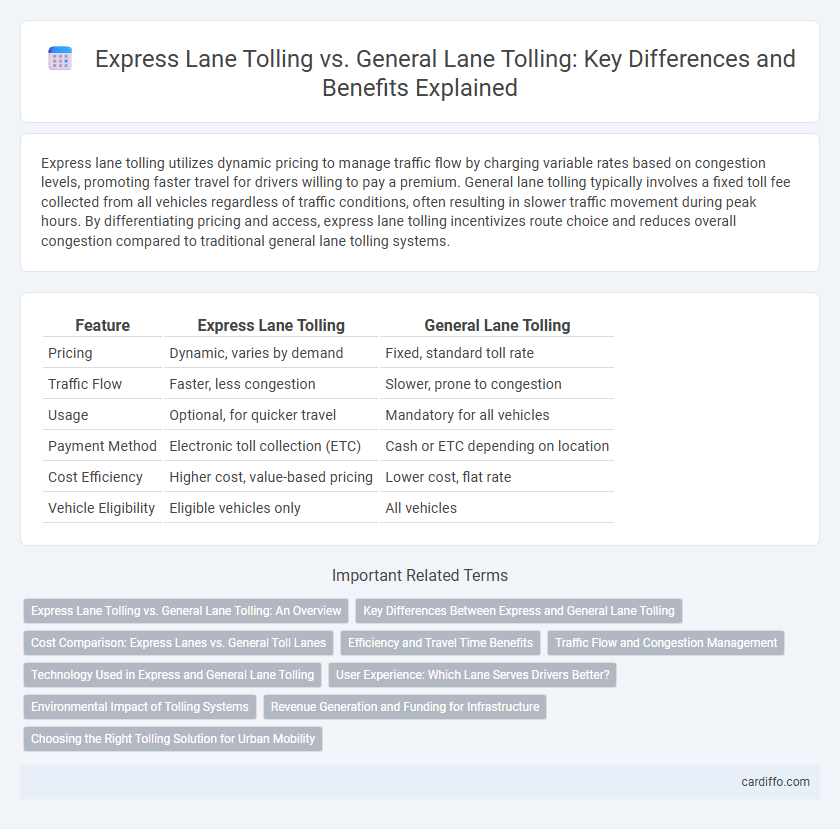Express lane tolling utilizes dynamic pricing to manage traffic flow by charging variable rates based on congestion levels, promoting faster travel for drivers willing to pay a premium. General lane tolling typically involves a fixed toll fee collected from all vehicles regardless of traffic conditions, often resulting in slower traffic movement during peak hours. By differentiating pricing and access, express lane tolling incentivizes route choice and reduces overall congestion compared to traditional general lane tolling systems.
Table of Comparison
| Feature | Express Lane Tolling | General Lane Tolling |
|---|---|---|
| Pricing | Dynamic, varies by demand | Fixed, standard toll rate |
| Traffic Flow | Faster, less congestion | Slower, prone to congestion |
| Usage | Optional, for quicker travel | Mandatory for all vehicles |
| Payment Method | Electronic toll collection (ETC) | Cash or ETC depending on location |
| Cost Efficiency | Higher cost, value-based pricing | Lower cost, flat rate |
| Vehicle Eligibility | Eligible vehicles only | All vehicles |
Express Lane Tolling vs. General Lane Tolling: An Overview
Express lane tolling employs dynamic pricing based on real-time traffic conditions, which helps regulate congestion and maintain higher travel speeds compared to general lane tolling, where flat or variable rates apply uniformly across lanes. Vehicles using express lanes often benefit from reduced travel times due to fewer cars and managed toll rates, whereas general lane tolling typically results in slower travel due to mixed traffic volumes. This pricing strategy in express lanes optimizes road capacity and enhances traffic flow efficiency, making it a preferred choice for time-sensitive commuters.
Key Differences Between Express and General Lane Tolling
Express lane tolling uses dynamic pricing based on real-time traffic conditions to manage congestion and maintain traffic flow, while general lane tolling typically charges a fixed fee regardless of traffic volume. Express lanes are often restricted to high-occupancy vehicles, buses, and drivers who pay tolls electronically, promoting carpooling and reducing delays. General lane tolling accommodates all vehicles but can lead to slower speeds and higher congestion during peak hours due to uniform toll charges.
Cost Comparison: Express Lanes vs. General Toll Lanes
Express lane tolling typically incurs higher fees than general toll lanes due to dynamic pricing models that adjust rates based on real-time traffic conditions and demand, promoting faster travel times. General toll lanes charge a fixed toll rate regardless of congestion, often resulting in lower costs but potential delays during peak hours. This cost difference reflects the trade-off between paying a premium for reduced travel time via express lanes and opting for the more economical option with general toll lanes.
Efficiency and Travel Time Benefits
Express lane tolling significantly enhances traffic efficiency by utilizing dynamic pricing to manage congestion, resulting in smoother traffic flow and reduced travel times. General lane tolling often causes bottlenecks due to uniform toll rates and slower processing at toll plazas, increasing delays during peak hours. Implementing express lane tolling optimizes roadway capacity, offering a reliable, faster travel option for commuters and freight transport.
Traffic Flow and Congestion Management
Express lane tolling utilizes dynamic pricing to regulate demand and maintain free-flow traffic conditions, effectively reducing congestion in high-traffic corridors. General lane tolling, often fixed-rate, can lead to slower traffic speeds and increased bottlenecks during peak hours due to uniform pricing regardless of congestion levels. By incentivizing off-peak travel and lane selection, express lane tolling optimizes traffic flow and enhances overall roadway efficiency.
Technology Used in Express and General Lane Tolling
Express lane tolling primarily relies on advanced electronic toll collection (ETC) systems such as RFID transponders and automatic license plate recognition (ALPR) cameras to enable seamless, high-speed transactions without disrupting traffic flow. General lane tolling often incorporates both traditional barrier-based toll booths with manual or electronic payment options and increasingly integrates ETC technology to reduce congestion and improve efficiency. The integration of real-time data analytics and vehicle classification sensors further enhances the accuracy and dynamic pricing capabilities in express lane tolling systems.
User Experience: Which Lane Serves Drivers Better?
Express lane tolling enhances user experience by minimizing congestion and reducing travel time, offering a smoother and faster journey compared to general lane tolling. The seamless electronic toll collection in express lanes eliminates the need for stopping, improving convenience and driver satisfaction. Conversely, general lane tolling often involves slower traffic flow and potential delays, negatively impacting overall user experience.
Environmental Impact of Tolling Systems
Express lane tolling reduces congestion by encouraging carpooling and optimizing traffic flow, leading to lower vehicle emissions compared to general lane tolling. General lane tolling often results in stop-and-go traffic due to slower processing, increasing fuel consumption and air pollution. Implementing dynamic pricing in express lanes further enhances environmental benefits by minimizing idling time and promoting efficient roadway usage.
Revenue Generation and Funding for Infrastructure
Express lane tolling generates higher revenue per vehicle compared to general lane tolling due to dynamic pricing models that adjust rates based on real-time traffic conditions. These premium tolls create a consistent funding stream dedicated to maintaining and expanding transportation infrastructure, enhancing overall network efficiency. By leveraging variable pricing, express lanes attract users willing to pay for reduced travel times, resulting in increased toll revenues that support sustainable infrastructure investment.
Choosing the Right Tolling Solution for Urban Mobility
Express lane tolling utilizes dynamic pricing to manage traffic flow and reduce congestion, enhancing travel efficiency on high-demand corridors. General lane tolling typically applies a flat fee, suitable for simpler road networks but less effective in modulating traffic volume during peak hours. Selecting the optimal tolling solution depends on urban mobility goals, traffic patterns, and technology infrastructure to balance revenue generation with improved commuter experience.
Express lane tolling vs general lane tolling Infographic

 cardiffo.com
cardiffo.com